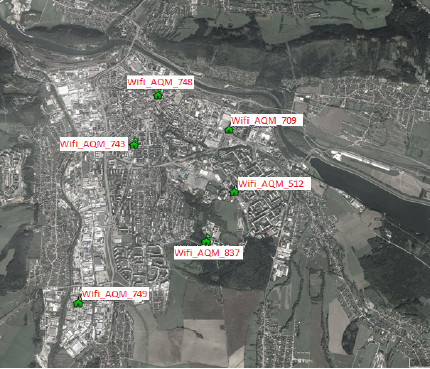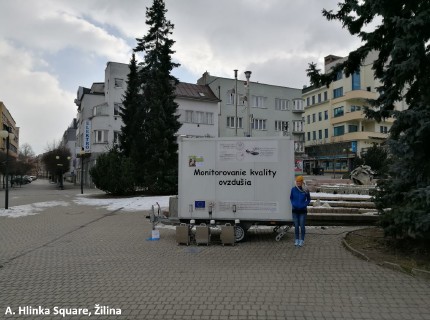Traffic pollution
The layout of the measuring stations was based on the basic idea of covering typical FUAs in the city of Žilina. There are five measuring stations in the city.

Figure 1 Air Quality Measurement Network in Žilina city
| Number | Measurement place | Device | FUAs |
| 1. | Univerzitná Street | Wifi_AQM_837 | Rod traffic, education |
| 2. | Štrková Street | Wifi_AQM_749 | Light industry, road traffic |
| 3. | Komenského Street | Wifi_AQM_743 | Road traffic, habitation |
| 4. | A. Hlinka Square | Wifi_AQM_748 | Walking zone, shopping |
| 5. | Košická Street | Wifi_AQM_709 | Road traffic, industry |
Air pollution measurements were focused on gaseous pollutant: nitrogen dioxide - NO2 and different fractions of particulate matter: PM10, PM2.5 and PM1 in the city of Žilina. Concentrations of pollutants were evaluated as 24-hour averages, i.e. 7 concentration values for each pollutant at each measuring station. The basic task was to compare concentrations of pollutants in different FUAs of Žilina. Measured air pollution may come from a variety of sources located around measuring stations.

Air pollution measurements have demonstrated the diversity of air quality in different urban areas. The decisive factor of impaired air quality was in particular the presence of road transport as well as meteorological parameters - measuring stations Komenského Street, Košická Street, Štrková Street. In terms of meteorological parameters, the air temperature and the wind speed (scattering conditions) were decisive - the measuring location of Komenská Street, A. Hlinka Square. Wet deposition in the self-cleaning of the atmosphere - Štrková Street (heavy rainfall) also played a big role.
Figure 2 The daily average concentrations of PM and selected meteorological parameters from air quality measurements in the Žilina city
Higher particulate concentrations of PM10, PM2.5 and PM1 were measured at measuring locations near roads and at the same time at worse dispersion conditions (low temperatures, low wind speed, inversion). The coarse fraction PM2.5-10 was more represented in the total PM10 fraction at the measurement sites near the roads and more favourable dispersion conditions were present. The fine particle fraction PM2.5 was most represented in the total PM10 fraction measured at the A. Hlinka square where low air temperatures were present and no road transport was present.
Figure 3 Polar plot for particulate matter (PM) at the measuring station on Komenského Street from 1st to 7th March 2018 (ws—wind speed)
Figure 4 The proportion of analyzed chemical element in particulate matter PM10 fraction – measuring station Košická Street
Several important information has been identified in the process of identifying particulate matter pollution sources. At each monitoring station several factors have been identified - sources of particulate matter air pollution and these have been named by the representation of metals in individual factors. The first factor is the most important and most closely reflects the origin of the solid particles at a given monitoring station. The found factor with the greatest influence on particle concentration is listed in the following table:
| Measuring station | Name of Factor 1 | Measurement period |
| Univerzitná Street | Road dust resuspension | November 2017 |
| A. Hlinka Square | Combustion – local, central heating | February 2018 |
| Komenského Street | Traffic related emissions | March 2018 |
| Košická Street | Road dust resuspension, traffic related emissions | April 2018 |
| Štrková Street | Industry, traffic related emissions | May 2018 |
Figure 5 Development process of actual pollutants concentrations in the environment observed in functional urban areas of Žilina city
Some initial actions were processed within the solution of activity A.T1.5: Specific air quality measurements and deliverable D.T1.5.2: Report on measuring traffic pollution: setting of measuring devices, creation of an air quality measurement network in Žilina (various FUAs), creation of external database of measured air quality data, location of measuring devices in various FUAs of Žilina, launch air quality measurements at different FUAs in Žilina. These activities were necessary for the subsequent implementation of air quality measurement of road traffic in different FUAs. The first air quality data was obtained, which was analysed and evaluated.
